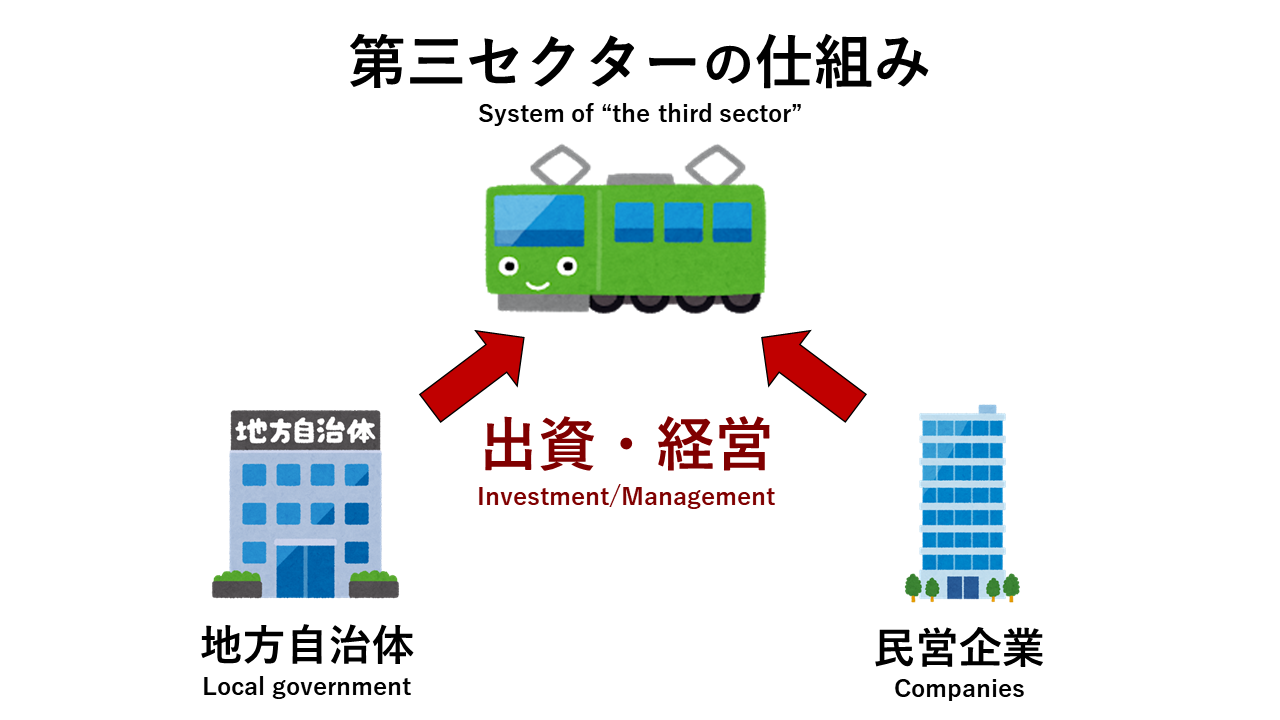Third sector
What is the "Third sector"?

"Public enterprises" operated by Japan like the Japan National Railways (now disappeared) are called the "First sector", "Private enterprises" managed by the private sector like Tokyu Corporation are called the "Second sector". Also, the enterprises that do not belong to either of the above, and which jointly invest in local governments and private enterprises operating businesses are generally called the "Third sector". In the railway industry, as a reason for such a form of company to start to be talked about, in discussing the abolition of the former national railway deficit route, local governments and others began to enter the business in order to survive the deficit route.In recent years, there are many cases where not only the third sector conversion of the deficit route but also the conventional line parallel by the opening of the Shinkansen has been transferred to the third sector in the form of business separation.
Merit
The merit is that it is easy to make flexible measures to match the local circumstances by taking advantage of the close contact with local governments and the know-how of private companies.
Demerit
The disadvantage is that there are many cases that inherit the route which originally had a bad management status, and because it is not funded, so it is not easy to make it profitable. Although it is good that it was made into the third sector, there are cases in which it will be forced to be abolished after a while without doing it. In that case, a large amount of taxes and funds that were input will be wasted.
Example of Sanriku Railway
The first railway which became third sector is “Sanriku Railway”. Sanriku Railway locates Pacific Ocean side in Tohoku. In past tense, Japan national railway built the railway and operated but Sanriku Railway inherited. The background of building railway, there is plan; penetrating Pacific Ocean side in Tohoku by railway. According to the plan, the existing railways were built for long years.
However, when the plan was pursued except for two sections; from Yoshihama station to Kamaishi station(15.2km) and from Taro station to Fudai station(32.2km), the construction was stopped due to financial aggravation of Japan national railway. To make matters worse, JNR (Japan national railway) Reconstruction Law was established so the Abolitions of Miyako Line (Taro-Miyako), Sakari Line (Sakari-Yoshihama) and Kuji Line (Fudai-Kuji) were decided. But, laying rail was finished in the two sections that didn’t operate, so Iwate prefecture and some cities or towns established the third sector whose name is “Sanriku Railway”. Sanriku railway opened the two sections and continued to operate three sections that were decided as abolition.
The sections opened in 1984, and they are divided as two new section; North Rias Line(Miyako-Kuji) and South Rias Line(Sakari-Kamaishi). Sanriku Railway raised fare and rationalized management ,so it turned into a surplus for ten years from 1984. In addition, Sanriku Railway also succeeded to shift to a sightseeing line. Therefore, Sanriku railway became famous as a model case which is success of shifting to third sector, and it affected other railway in Japan.
Becoming a third sector following the opening of the Shinkansen
There some cases which shifted to third sector related to opening of Shinkansen. For example, Ainokaze Toyama Railway and IR Ishikawa were shifted from JR line because of opening of Hokuriku Shinkansen(Tokyo-Kanazawa).
Before shifting to those railways, the limited express trains(“Thunderbird” and “Hakutaka”) were operated. These limited express trains were very popular, but their operations were reduced or abolished because of opening of Hokuriku Shinkansen. Though a reducing of number of passengers was expected because limited express trains were reduced or abolished, existence of kind of big cities and new operations; charged commuter liner were able to railway not to decrease their passengers.

